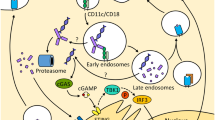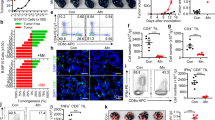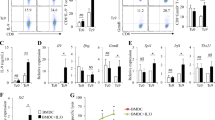Abstract
In addition to direct tumor cell cytotoxicity, chemotherapy can mediate tumor reduction through immune modulation of the tumor microenvironment to promote anti-tumor immunity. Mature dendritic cells (DCs) play key roles in priming robust immune responses in tumor-bearing hosts. Here, we screened a panel of 21 anticancer agents with defined molecular targets for their ability to induce direct maturation of DCs. We identified ansamitocin P3, a microtubule-depolymerizing agent, as a potent inducer of phenotypic and functional maturation of DCs. Exposure of both murine spleen-derived and human monocyte-derived DCs to ansamitocin P3 triggered up-regulation of maturation markers and production of pro-inflammatory cytokines, resulting in an enhanced T cell stimulatory capacity. Local administration of ansamitocin P3 induced maturation of skin Langerhans cells in vivo and promoted antigen uptake and extensive homing of tumor-resident DCs to tumor-draining lymph nodes. When used as an adjuvant in a specific vaccination approach, ansamitocin P3 dramatically increased activation of antigen-specific T cells. Finally, we demonstrate that ansamitocin P3, due to its immunomodulatory properties, acts in synergy with antibody-mediated blockade of the T cell inhibitory receptors PD-1 and CTLA-4. The combination treatment was most effective and induced durable growth inhibition of established tumors. Mechanistically, we observed a reduced regulatory T cell frequency and improved T cell effector function at the tumor site. Taken together, our study unravels an immune-based anti-tumor mechanism exploited by microtubule-depolymerizing agents, including ansamitocin P3, and paves the way for future clinical trials combining this class of agents with immunotherapy.






Similar content being viewed by others
References
Drake CG, Lipson EJ, Brahmer JR (2014) Breathing new life into immunotherapy: review of melanoma, lung and kidney cancer. Nat Rev Clin Oncol 11(1):24–37. doi:10.1038/nrclinonc.2013.208
Hamid O, Robert C, Daud A, Hodi FS, Hwu WJ, Kefford R, Wolchok JD, Hersey P, Joseph RW, Weber JS, Dronca R, Gangadhar TC, Patnaik A, Zarour H, Joshua AM, Gergich K, Elassaiss-Schaap J, Algazi A, Mateus C, Boasberg P, Tumeh PC, Chmielowski B, Ebbinghaus SW, Li XN, Kang SP, Ribas A (2013) Safety and tumor responses with lambrolizumab (anti-PD-1) in melanoma. N Engl J Med. doi:10.1056/NEJMoa1305133
Wolchok JD, Kluger H, Callahan MK, Postow MA, Rizvi NA, Lesokhin AM, Segal NH, Ariyan CE, Gordon RA, Reed K, Burke MM, Caldwell A, Kronenberg SA, Agunwamba BU, Zhang X, Lowy I, Inzunza HD, Feely W, Horak CE, Hong Q, Korman AJ, Wigginton JM, Gupta A, Sznol M (2013) Nivolumab plus ipilimumab in advanced melanoma. N Engl J Med. doi:10.1056/NEJMoa1302369
Bracci L, Schiavoni G, Sistigu A, Belardelli F (2014) Immune-based mechanisms of cytotoxic chemotherapy: implications for the design of novel and rationale-based combined treatments against cancer. Cell Death Differ 21(1):15–25. doi:10.1038/cdd.2013.67
Chen G, Emens LA (2013) Chemoimmunotherapy: reengineering tumor immunity. Cancer Immunol Immunother 62(2):203–216. doi:10.1007/s00262-012-1388-0
Lake RA, Robinson BW (2005) Immunotherapy and chemotherapy—a practical partnership. Nat Rev Cancer 5(5):397–405
Gajewski TF, Schreiber H, Fu YX (2013) Innate and adaptive immune cells in the tumor microenvironment. Nat Immunol 14(10):1014–1022. doi:10.1038/ni.2703
Zitvogel L, Galluzzi L, Smyth MJ, Kroemer G (2013) Mechanism of action of conventional and targeted anticancer therapies: reinstating immunosurveillance. Immunity 39(1):74–88. doi:10.1016/j.immuni.2013.06.014
Palucka K, Banchereau J (2012) Cancer immunotherapy via dendritic cells. Nat Rev Cancer 12(4):265–277. doi:10.1038/nrc3258
Hargadon KM (2013) Tumor-altered dendritic cell function: implications for anti-tumor immunity. Front Immunol 4:192. doi:10.3389/fimmu.2013.00192
Kroemer G, Galluzzi L, Kepp O, Zitvogel L (2013) Immunogenic cell death in cancer therapy. Annu Rev Immunol 31:51–72. doi:10.1146/annurev-immunol-032712-100008
van de Ven R, Reurs AW, Wijnands PG, van Wetering S, Kruisbeek AM, Hooijberg E, Scheffer GL, Scheper RJ, de Gruijl TD (2012) Exposure of CD34+ precursors to cytostatic anthraquinone-derivatives induces rapid dendritic cell differentiation: implications for cancer immunotherapy. Cancer Immunol Immunother 61(2):181–191. doi:10.1007/s00262-011-1039-x
Mizumoto N, Gao J, Matsushima H, Ogawa Y, Tanaka H, Takashima A (2005) Discovery of novel immunostimulants by dendritic-cell-based functional screening. Blood 106(9):3082–3089. doi:10.1182/blood-2005-03-1161
Tanaka H, Matsushima H, Mizumoto N, Takashima A (2009) Classification of chemotherapeutic agents based on their differential in vitro effects on dendritic cells. Cancer Res 69(17):6978–6986. doi:10.1158/0008-5472.CAN-09-1101
Tanaka H, Matsushima H, Nishibu A, Clausen BE, Takashima A (2009) Dual therapeutic efficacy of vinblastine as a unique chemotherapeutic agent capable of inducing dendritic cell maturation. Cancer Res 69(17):6987–6994. doi:10.1158/0008-5472.CAN-09-1106
Nalbandian G, Paharkova-Vatchkova V, Mao A, Nale S, Kovats S (2005) The selective estrogen receptor modulators, tamoxifen and raloxifene, impair dendritic cell differentiation and activation. J Immunol 175(4):2666–2675
Hipp MM, Hilf N, Walter S, Werth D, Brauer KM, Radsak MP, Weinschenk T, Singh-Jasuja H, Brossart P (2008) Sorafenib, but not sunitinib, affects function of dendritic cells and induction of primary immune responses. Blood 111(12):5610–5620. doi:10.1182/blood-2007-02-075945
Bros M, Jahrling F, Renzing A, Wiechmann N, Dang NA, Sutter A, Ross R, Knop J, Sudowe S, Reske-Kunz AB (2007) A newly established murine immature dendritic cell line can be differentiated into a mature state, but exerts tolerogenic function upon maturation in the presence of glucocorticoid. Blood 109(9):3820–3829. doi:10.1182/blood-2006-07-035576
Abeyama K, Eng W, Jester JV, Vink AA, Edelbaum D, Cockerell CJ, Bergstresser PR, Takashima A (2000) A role for NF-kappaB-dependent gene transactivation in sunburn. J Clin Invest 105(12):1751–1759. doi:10.1172/JCI9745
Daniels MA, Teixeiro E, Gill J, Hausmann B, Roubaty D, Holmberg K, Werlen G, Hollander GA, Gascoigne NR, Palmer E (2006) Thymic selection threshold defined by compartmentalization of Ras/MAPK signalling. Nature 444(7120):724–729. doi:10.1038/nature05269
Meidenbauer N, Zippelius A, Pittet MJ, Laumer M, Vogl S, Heymann J, Rehli M, Seliger B, Schwarz S, Le Gal FA, Dietrich PY, Andreesen R, Romero P, Mackensen A (2004) High frequency of functionally active melan-a-specific T cells in a patient with progressive immunoproteasome-deficient melanoma. Cancer Res 64(17):6319–6326. doi:10.1158/0008-5472.CAN-04-1341
West MA, Wallin RP, Matthews SP, Svensson HG, Zaru R, Ljunggren HG, Prescott AR, Watts C (2004) Enhanced dendritic cell antigen capture via toll-like receptor-induced actin remodeling. Science 305(5687):1153–1157. doi:10.1126/science.1099153
West AC, Mattarollo SR, Shortt J, Cluse LA, Christiansen AJ, Smyth MJ, Johnstone RW (2013) An intact immune system is required for the anticancer activities of histone deacetylase inhibitors. Cancer Res. doi:10.1158/0008-5472.CAN-13-0890
Mattarollo SR, Loi S, Duret H, Ma Y, Zitvogel L, Smyth MJ (2011) Pivotal role of innate and adaptive immunity in anthracycline chemotherapy of established tumors. Cancer Res 71(14):4809–4820. doi:10.1158/0008-5472.CAN-11-0753
Probst HC, McCoy K, Okazaki T, Honjo T, van den Broek M (2005) Resting dendritic cells induce peripheral CD8+ T cell tolerance through PD-1 and CTLA-4. Nat Immunol 6(3):280–286. doi:10.1038/ni1165
Nishikawa H, Sakaguchi S (2010) Regulatory T cells in tumor immunity. Int J Cancer 127(4):759–767. doi:10.1002/ijc.25429
Waitz R, Solomon SB, Petre EN, Trumble AE, Fasso M, Norton L, Allison JP (2012) Potent induction of tumor immunity by combining tumor cryoablation with anti-CTLA-4 therapy. Cancer Res 72(2):430–439. doi:10.1158/0008-5472.CAN-11-1782
Mantovani A, Germano G, Marchesi F, Locatelli M, Biswas SK (2011) Cancer-promoting tumor-associated macrophages: new vistas and open questions. Eur J Immunol 41(9):2522–2525. doi:10.1002/eji.201141894
Liu C, Chari RV (1997) The development of antibody delivery systems to target cancer with highly potent maytansinoids. Expert Opin Investig Drugs 6(2):169–172. doi:10.1517/13543784.6.2.169
Cassady JM, Chan KK, Floss HG, Leistner E (2004) Recent developments in the maytansinoid antitumor agents. Chem Pharm Bull (Tokyo) 52(1):1–26
Issell BF, Crooke ST (1978) Maytansine. Cancer Treat Rev 5(4):199–207
Alley SC, Okeley NM, Senter PD (2010) Antibody-drug conjugates: targeted drug delivery for cancer. Curr Opin Chem Biol 14(4):529–537. doi:10.1016/j.cbpa.2010.06.170
Chari RV, Martell BA, Gross JL, Cook SB, Shah SA, Blattler WA, McKenzie SJ, Goldmacher VS (1992) Immunoconjugates containing novel maytansinoids: promising anticancer drugs. Cancer Res 52(1):127–131
Sievers EL, Senter PD (2013) Antibody-drug conjugates in cancer therapy. Annu Rev Med 64:15–29. doi:10.1146/annurev-med-050311-201823
Prota AE, Bargsten K, Zurwerra D, Field JJ, Diaz JF, Altmann KH, Steinmetz MO (2013) Molecular mechanism of action of microtubule-stabilizing anticancer agents. Science 339(6119):587–590. doi:10.1126/science.1230582
Venghateri JB, Gupta TK, Verma PJ, Kunwar A, Panda D (2013) Ansamitocin p3 depolymerizes microtubules and induces apoptosis by binding to tubulin at the vinblastine site. PLoS one 8(10):e75182. doi:10.1371/journal.pone.0075182
John J, Ismail M, Riley C, Askham J, Morgan R, Melcher A, Pandha H (2010) Differential effects of paclitaxel on dendritic cell function. BMC Immunol 11:14. doi:10.1186/1471-2172-11-14
Kolomeichuk SN, Terrano DT, Lyle CS, Sabapathy K, Chambers TC (2008) Distinct signaling pathways of microtubule inhibitors–vinblastine and taxol induce JNK-dependent cell death but through AP-1-dependent and AP-1-independent mechanisms, respectively. FEBS J 275(8):1889–1899. doi:10.1111/j.1742-4658.2008.06349.x
Banchereau J, Steinman RM (1998) Dendritic cells and the control of immunity. Nature 392(6673):245–252. doi:10.1038/32588
Fiorentino DF, Zlotnik A, Vieira P, Mosmann TR, Howard M, Moore KW, O’Garra A (1991) IL-10 acts on the antigen-presenting cell to inhibit cytokine production by Th1 cells. J Immunol 146(10):3444–3451
Steinbrink K, Wolfl M, Jonuleit H, Knop J, Enk AH (1997) Induction of tolerance by IL-10-treated dendritic cells. J Immunol 159(10):4772–4780
De Monte L, Reni M, Tassi E, Clavenna D, Papa I, Recalde H, Braga M, Di Carlo V, Doglioni C, Protti MP (2011) Intratumor T helper type 2 cell infiltrate correlates with cancer-associated fibroblast thymic stromal lymphopoietin production and reduced survival in pancreatic cancer. J Exp Med 208(3):469–478. doi:10.1084/jem.20101876
Cheong C, Matos I, Choi JH, Dandamudi DB, Shrestha E, Longhi MP, Jeffrey KL, Anthony RM, Kluger C, Nchinda G, Koh H, Rodriguez A, Idoyaga J, Pack M, Velinzon K, Park CG, Steinman RM (2010) Microbial stimulation fully differentiates monocytes to DC-SIGN/CD209 (+) dendritic cells for immune T cell areas. Cell 143(3):416–429. doi:10.1016/j.cell.2010.09.039
Ma Y, Adjemian S, Mattarollo SR, Yamazaki T, Aymeric L, Yang H, Portela Catani JP, Hannani D, Duret H, Steegh K, Martins I, Schlemmer F, Michaud M, Kepp O, Sukkurwala AQ, Menger L, Vacchelli E, Droin N, Galluzzi L, Krzysiek R, Gordon S, Taylor PR, Van Endert P, Solary E, Smyth MJ, Zitvogel L, Kroemer G (2013) Anticancer chemotherapy-induced intratumoral recruitment and differentiation of antigen-presenting cells. Immunity 38(4):729–741. doi:10.1016/j.immuni.2013.03.003
Robert C, Thomas L, Bondarenko I, O’Day S, M DJ, Garbe C, Lebbe C, Baurain JF, Testori A, Grob JJ, Davidson N, Richard J, Maio M, Hauschild A, Miller WH, Gascon P, Lotem M, Harmankaya K, Ibrahim R, Francis S, Chen TT, Humphrey R, Hoos A, Wolchok JD (2011) Ipilimumab plus dacarbazine for previously untreated metastatic melanoma. N Engl J Med 364(26):2517–2526. doi:10.1056/NEJMoa1104621
Topalian SL, Drake CG, Pardoll DM (2012) Targeting the PD-1/B7-H1 (PD-L1) pathway to activate anti-tumor immunity. Curr Opin Immunol 24(2):207–212. doi:10.1016/j.coi.2011.12.009
Hamid O, Carvajal RD (2013) Anti-programmed death-1 and anti-programmed death-ligand 1 antibodies in cancer therapy. Expert Opin Biol Ther 13(6):847–861. doi:10.1517/14712598.2013.770836
Curran MA, Montalvo W, Yagita H, Allison JP (2010) PD-1 and CTLA-4 combination blockade expands infiltrating T cells and reduces regulatory T and myeloid cells within B16 melanoma tumors. Proc Natl Acad Sci 107(9):4275–4280. doi:10.1073/pnas.0915174107
Sica A, Mantovani A (2012) Macrophage plasticity and polarization: in vivo veritas. J Clin Invest 122(3):787–795. doi:10.1172/JCI59643
Acknowledgments
This work was supported by grants from the Swiss National Science Foundation, the Wilhelm-Sander-Foundation, the Cancer League Basel, and the Huggenberger Stiftung. We thank Béatrice Dolder-Schlienger, Mélanie Buchi, and Petra Herzig for excellent technical assistance; Arne Sutter (Merck KGaA) for providing the SP37A3 cell line; the Developmental Therapeutics Program at NCI/NIH for providing ansamitocin P3, vinblastine, vindesine, and vinorelbine; Jean Pieters for providing OT-II mice; and Douglas Fearon and Mark Smyth for providing tumor cell lines. Furthermore, we thank Heinz Läubli, Narasimha Rao Uda, and Matthias Kreuzaler for critical reading of the manuscript.
Conflict of interest
The authors declare no conflicts of interest.
Author information
Authors and Affiliations
Corresponding authors
Additional information
K. Martin and P. Müller have contributed equally to this work.
Electronic supplementary material
Below is the link to the electronic supplementary material.
Rights and permissions
About this article
Cite this article
Martin, K., Müller, P., Schreiner, J. et al. The microtubule-depolymerizing agent ansamitocin P3 programs dendritic cells toward enhanced anti-tumor immunity. Cancer Immunol Immunother 63, 925–938 (2014). https://doi.org/10.1007/s00262-014-1565-4
Received:
Accepted:
Published:
Issue Date:
DOI: https://doi.org/10.1007/s00262-014-1565-4




